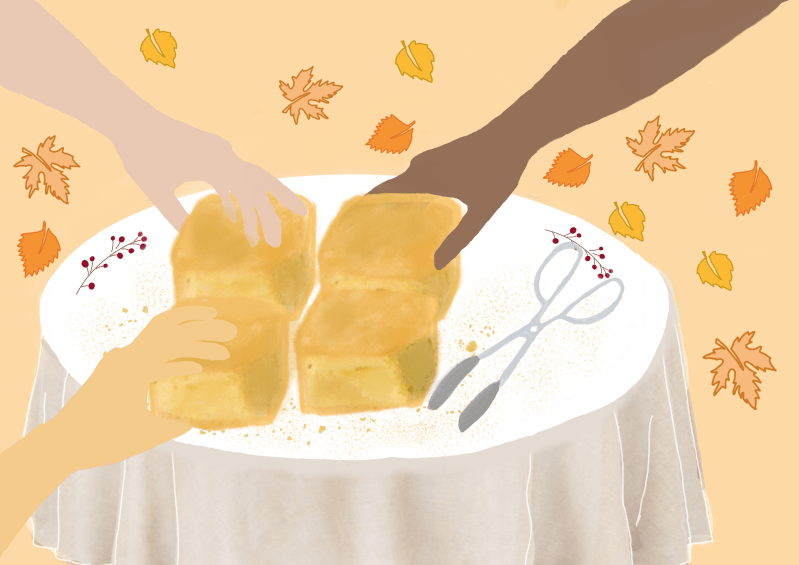It’s that time of year again: trees losing leaves as the nights grow longer and chillier, the holidays lying sleepily just around the corner as the seductively-sweet scent of pumpkin spice fills the air (or, at least, the air that all poets seem to breathe during the change of seasons). That said, this will not be yet another article singing the overdone praises of pumpkin spice (the PSL has been around since August this year, August), so I instead want to draw attention to pumpkin pie’s humblest of companions: cornbread.
When you hear the word “cornbread,” what comes to mind? Does your mouth water in anticipation of the sugary, cake-like accompaniment to some good, old-fashioned ‘cue, or do you instead smell the enticing butteriness of the denser, unsweetened iteration, still sizzling within its cast iron cage? Maybe you picture something else entirely: the crispy fried exterior, doused in breakfast syrup, of course, of a perfectly-pillowy johnnycake.
Cornbread is complicated, so much so that even its name is riddled with ambiguity. Johnnycakes, fry breads, hushpuppies, arepas and even tortillas qualify as types of cornbread. There is also the matter of how sweet a “proper” cornbread is; while Jiffy’s classic, sugary mix is nostalgic for many, true Southerners, including esteemed author Mark Twain, continue to denounce this Northern interpretation of the beloved staple. Thus, for a humble side dish, cornbread bears a rich and divisive history, which, in anticipation of its undoubted prevalence on holiday dinner tables for years to come, deserves exploration.
As “Southern Living” Test Kitchen Director Robby Melvin explains, what we know today as Southern cornbread began as the product of necessity in the early 18th century. Growing wheat was quite difficult in the colonial South as it would quickly turn rancid from the heat, so wheat flour was a luxury enjoyed only by rich landowners. In contrast, corn was a sturdier grain that had been used centuries earlier by the Aztecs and Mayans, who ground the kernels into a thick meal before pressing the mixture into tortillas. Poorer colonists emulated this process, creating a simple mixture of cornmeal and water that was baked over a hearth and eaten plain or — if they could afford it — with beans.
Understandably, it did not take long for Southerners to start looking for ways to make cornbread actually taste good. They experimented with the addition of farmed products, many of which were pig-based. These included bacon fat, rendered ham hog fat, eggs and buttermilk — all of which imparted flavor and richness to the final product. They also modified the baking process, pouring the mixture directly into a heated cast-iron skillet covered with butter or bacon drippings. Noticeably absent from these recipes, however, was sugar.
Things take a darker turn when discussing cornbread derivatives. Cornbread dressing, the quintessential Thanksgiving side, originated from kush (sometimes called “Confederate cush” in reference to its popularity during the Civil War), a cornbread scramble made by enslaved peoples. For them, kush was a distant memory of kusha, an Islamic West African staple similar to couscous that is speculated to have developed in Senegambia and the Sahel. Whereas a quick Google search for “cornbread dressing” yields recipes calling for sage pork sausages or thick-cut bacon, the original dish was a struggle food put together from the meager rations granted by slave owners. A pinch of salt or an old onion were common additions to the cornmeal base, with pork trimmings being a rare treat.
These early cornbreads are still a far cry from the fluffy fall favorite we enjoy now. In addition to lacking sugar and wheat flour, early versions didn’t have leavening agents. Substances like baking soda and buttermilk that give modern cornbread its rise were not used until the 19th century. Although 18th century recipes can be found today, the key ingredients — buttermilk in particular — have themselves evolved over time, so much so that it is virtually impossible to recreate the original.
How did we end up with the characteristically-cakey cornbread served at BBQ joints? According to Serious Eats, as milling technologies improved, traditional stone mills were phased out in favor of more efficient steel roller mills in the early 20th century. This dramatically changed the quality of cornmeal; the heat produced by steel rollers degraded corn kernels — thus, reducing its natural sweetness and flavor — and reduced the particle size, which would weaken the structural quality of cornbread. To adapt to these challenges, the additions of sugar, wheat flour and chemical leaveners like baking soda transformed cornbread from a limp, patty-like bread to the more indulgent version popular with young children today.
Some might find it odd that I, an Asian-American woman, have chosen to discuss cornbread, a dish far removed from my own cultural background, and I freely acknowledge that I may not be the best primary source on its traditional value. That said, to get preach-y for a moment, it is my strong belief that learning the history of all foods is important (though particularly so for the foods we love), and, for me, like many Americans, cornbread is one of my favorites. As we approach the holiday season, I hope to have inspired you to recall — if even just for a second — the rich, multicultural origins of humble cornbread as you reach for that inevitable extra helping.
Editor’s Note: This article includes subjective opinions, thoughts and critiques.
